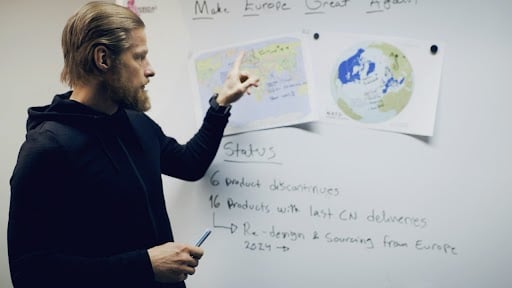Our MEGA project is moving ahead! For most of our Made in China products, the final shipments are now arriving before we shut down our production in China. One could say that these are historic batches, proper collector’s items, that we have in our hands!
Let’s recall what this project is about. We are getting rid of our production in China. With this move, we will improve our supply security and lean a bit more on the side of the good guys, because well, China. By relocating the production to Europe, we can restock our products evenly, in smaller quantities. The shipping will take under a week, which is significantly faster compared to the two months it takes currently. So, the availability of our products will improve without bloating our warehouse. At the same time, we are doing our (tiny) part to revive the European textile industry.
Departure from China - but not entirely
When it comes to raw materials, such as minerals, the dependency on China has been recognized quite well. But we could make some more noise about the textile industry. China has a big impact on the European textile sector; one-third of all imported clothing comes from China (Statista, 2021), measured in USD. Nobody will miss the infamous fast fashion dominating the headlines, should it ever disappear from the Earth. However, China has a crucial role as the producer of textiles and raw materials used by the defense sector, among others. If trade relations become turbulent, we might need to start making camo out of linen fabric, as some 70% of synthetic raw materials produced globally originate in China (Statista, 2022).
Reciprocally, Europe lacks local raw materials, yarn, and fabric makers that could replace our entire supply chain. Therefore, China cannot be completely erased from the production. This is also why, in all honesty, our MEGA project will also have a lesser impact than desired. Nonetheless, more money is directed towards the assembly of clothing and gear in Europe.
That money pales in comparison when looking at the big picture: the textile trade between the EU and the rest of the world adds up to a whopping 200 billion euros (Euratex, 2022), which is more than ever before. The EU trade deficit in textiles is some 70 billion euros, almost 50% more than the previous year (Euratex, 2022). Varusteleka’s trade with China in 2022 amounted to approximately 1,5 million euros.
By looking at these numbers, it is easy to conclude that the production of clothes and textiles should be reduced in general. If clothes were manufactured and purchased only for actual needs and worn until they fall apart, maybe we would be ready to pay a little more for the stuff we buy.
What's Next in the Pipeline?
The MEGA project is at the point where most of our production in China is ending. Next spring, the freshly made-in-Europe products will start replacing the made-in-China ones. As part of the move, the products will go through a redesign process. This will affect the product features and likely raise the prices as well. So if you wish to have one of the products as it currently is, now would be a good time to act on it!
Products with the Last Deliveries from China
- Särmä Backpack Rain Cover
- Särmä Women's Shorts
- Särmä Shorts
- Särmä Outdoor Shorts
- Särmä Rain Poncho
- Särmä Cap
- Särmä Cap with Mesh
- Särmä Women's Cargo Pants
- Särmä Windproof Anorak
- Särmä Windproof Smock, other colors except for black
- Särmä Hardshell Jacket
- Särmä Hardshell Pants
Discontinued Products
- Särmä Windproof Fishtail Parka
- Särmä Windproof Parka
- Särmä Outdoor Pants
- Särmä Outdoor Jacket
- Särmä Sternum Strap
- Särmä Jacket Liner
- Särmä Duffel Bag
- Särmä Duffel Bag, Small
- Särmä Wool Coat
- Särmä Pea Coat

